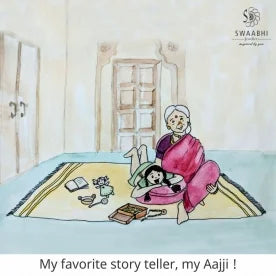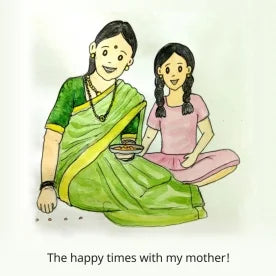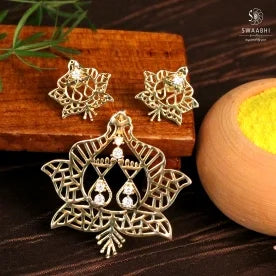With that, she concluded the elaborate story, leaving us awestruck and humbled! There was no internet at that time, and family’s traditional knowledge was seldom printed; it was handed down generation to generation by word of mouth. That preserved its authenticity whilst also giving the generations a freedom to add something of their own era to the ancient knowledge and tales.Indian culture has been by far and wide preserved this way, by the means of playing kaan goshti — tales passed from one Ajji to one Naat (grand-daughter) like me!

One Story Seven Ornaments
As a kid, I have been brought up in a typical Indian joint-family consisting of more than 25 family members!
We all used to live in a Waada (Mansion), a typical Puneri (A city in Maharashtra) ancient structure. The Waada had multiple rooms including a common kitchen and an Aangan(Garden) where every day we used to worship Tulshi Vrundawan(Basil Plant). For women of the house, the day used to start as early as 7am in the morning and used to end after every member of the family had their dinner in Pangat (Indian traditional system of have meals together).
There were total seven ladies in the house including my Aajj (Grandmother)! My Aajji was the pillar of our family who kept everyone bonded together with discipline, traditional systems and of course a lot of love! Most of the women in our house were home-makers — the busiest ones in the home! I have seen them all cooking in large quantities every day in gigantic vessels. My Aai(Mother)regularly used to make more than 100 Chapaties(breads) a day. My Kakus(Aunties) used to be busy cutting the vegetables while my Aaji used to be the most disciplined manager and the ultimate decision maker in the home. After the dinner, all of these busy ladies used to have their light moments, laughing and talking with each other while washing the utensils! It was always a warming sight to watch them like this!
The extended family meant that we all cousins got to be brought-up together like real brothers and sisters! Imagine the fun that we must’ve have had! We used to switch, share our rooms, cupboards, toys, clothes and all most everything without thinking twice. It was carefree and a time full of joy!
The men in the house were working hard to create a better living for us but one thing was prominent that having our family around was our biggest wealth. Apart from the daily routine and fun, one of the happiest times for all of the kids was the festival times! It was the time when our Aai, Baba(Father), Kaka(Uncles), Kaku used to gift us new cloths, new toys and lots of Mithai(Indian Sweets)! Apart from that, the women in the house used to make amazing homemade delicacies like Gulabjamun, Jilebi, Rabi Laddus, Chivada, Chakli, Shankarpale etc.
My Aajji used to make sure that we celebrate each festival elaborately with detailed preparations. She looked to it that everything happens as per the Shashra Paddhati(Indian scientific rituals)One of the most awaited times were when Aaji used to tell us the mythological stories and the importance of festivals. She loved telling us those stories that unfold our rich Indian culture. She always used to make us feel proud by telling us that we all belong to this prosperous Indian culture and how we are the one who are responsible to carry forward this legacy.
She was so particular about every planning that went in for the festivals’ celebrations that we all used to make sure not to miss any of the Poojas (Prayers & rituals) and Prasads (Sacred food that is distributed after the rituals). While celebrating festivals, performing Poojas, she wanted everything to be done neatly- with the faith in the god, in family traditions and in the rituals that are being performed.
All women in the house used to wait for the first day of the month Shravan. This day used to be one of the happiest days for all our Aai & Kakus. But what was so special about this first day?
Everyone along with me and my sister used to go to my Aajji’s room after the lunch. She had a big ancient wooden cupboard in her room which had multitude of small drawers, some of which were hidden, not visible easily. Each drawer had a different key and technique to open it. That cupboard was one of the most precious things for her! It not only stored all the important documents and savings in it, but also stored the enchanting traditional Karagiri gold ornaments. My Aai along with all my Kakus had given all their ornaments to my Aajji, which she used to wrap gently in white Suti Kapad (Cotton Cloth) and keep safe in that cupboard. During the Poojas and the festivals, she wanted all her daughter-in laws to wear these gold ornaments as a symbol of Saubhagya. On the first day of Shravan(Season), she used to distribute these traditional gold ornaments to each woman in the house.
The wooden cupboards with many small compartments to keep the jewellery safe.
She used to be the one to decide which ornament should be given to whom. She used to ask all my Kakus to bring in their festival sarees. According to the colour of the Saree(Indian Attire for females), the Butti (type of a patterns) and the pattern of it, she used to mix and match and give the ornaments to us. I remember her asking each one of us to stand in front of her and keep the Saree on the shoulder. Then she used to meticulously pull out ornaments from that big carved wooden box. Based on her observations of our personality, complexion, height and body type, she used to decide with utmost care and detail that which ornament will suit us the best. How she loved styling us! My Aai and Kakus believed from experience that she had an amazing aesthetic and styling sense and hence never doubted her decision.
It was one of those first days of Shravan, when Aajji called every one of us in her room post lunch. As the tradition follows we went to her room with the garments we had decided to wear for the upcoming festivals. When we went to her room she was little tired. This time she had already taken that wooden box out of her cupboard and it was open. She called my Aai as she was her eldest daughter-in-law and said, “I think it’s time you all decide how to distribute these ornaments among yourselves. I have grown old and the trend also has changed. I don’t think I will be able to keep up with this responsibility. It’s time for me to retire from these household responsibilities.”
We all were really surprised to hear that. Aajji indeed was getting old but somehow we never thought that she would give up that one thing which she loved to do the most! After listening to her, my Aai courageously replied “Mothi Aai, we all agree to most of your decisions by choice and not because of any obligations. But I think this one is too much of a responsibility at our end. And also, everyone loves the way you distribute ornaments after understanding our attire as you know the details and importance of each ornaments that we all are unaware about.”
Aajji calmly replied “I am aware of that and that is the main reason why I want all of you to take this responsibility. The knowledge and the skills which I have acquired from our fore-fathers needs to be passed on to the next generations! So I have made a decision that you all are going to take this responsibility. Come on let me tell you the importance of each ornament”
Aajji was so firm on her decision and her motive was well reasoned that we had to agree, but we knew in our hearts that were going to miss her styling! That day turned out to be precious. We all were absolutely enlightened with her detailed thought process and the way she explained each ornament.
She said, “We all are blessed to have a variety of Maharashtrian jewellery that comes with intricate designs and detailed Karagiri (artisanship). Most of the Maharastrain jewellery is named after the Goddesses for a simple reason that our Goddesses are a symbol of Saubhagya, which is good fortune. The designs are inspired from the shapes of Shubhachinhe (auspicious symbols), food grains, leaves etc. carved with the pictures of the Gods & Goddesses. Laxmihaar and Putalihaar are designed with a thought of merging with God in your mind. God is nothing but a positive energy and our ornaments thus are the carriers of positive energies.
Trditional Maharastrian Nath(Nose Ornament)
Aajji started with saying, “One of most important ornament in our tradition is our Khandani Maharashtrian Nath . Nath signifies saubhagya, royalty and elegance. Our ancestors have designed this Nath in the era of Peshwas (Warriors of Maratha Empire) which is made up of Basra Moti (Perals) , Manik (Ruby) , Hira (Diamond) and Pachu (Emerald); the gems of fortune. Bigger the Nath, wealthier is the family. But wealth here doesn’t only mean money, it also means having Sanskar . If you have ever noticed, the traditional Naths are heavier and bigger than the latest Naths . In the olden days the Karagir used to deliberately make Naths heavy. These heavy Naths used to keep our necks little down and conveniently deliver respect to every elder person around. The size of the Naths also used to be big enough to touch our lips because of which we have to speak softly.
But all this is a part of old beliefs, orthodox way of thinking. According to me, Nath is an ornament that represents boldness and also a woman’s strength. It makes women look strong yet beautiful.” And she handed over the traditional Naths to all her daughter-in-laws.
Kolhapuri Saaj
After distributing the Naths, she then delicately opened a smooth red coloured, velvet jewellery box. While opening she started sharing the further information, “This is known as the Kolkapuri Saaj. This ornament is very popular for its intricate design and grandeur. Look at the traditional Karagiri! It has 21 leaves complete with hanging gold droplets beautifully designed on lakh and plated with pure gold. This ornament was once very popular in Kolhapur (a town in Maharashtra) that’s why it’s named as the Kolhapuri Saaj! The 10 leaves out of the 21 are considered to be lord Vishnu’s avatars and the next 8 leaves are considered to be Ashtamandal.
The last leaf is nothing but the main pendant made up of pure Manik.Can you see the detailed carving on the leaves with symbols like fish, lotus, moon, Bel leaf, shell, and tortoise? These symbols are considered to be Shubhachinha. This ornament goes very well on Navvari Sari. Whenever you are opting for traditional Jari Sarees, Kolhapuri Saaj goes absolutely well with it.”
Vajratik
After she handed over the Kolhapuri Saaj, she then opened the box of marvelous Vajratik!
“This is one of my favorite ornaments. Vajratik! If you wear it on right occasion and with right attire, your true inner strength is reflected through your look.” She continued, “Vajra is a weapon won in battle, which is used as a ritual object to symbolize thunderbolt. It is considered to be a weapon of god Indra, who is the king of all gods. Indra’s weapon was called as Vajra which controlled the thunderbolts. Can you see these vertical & linear lines made on the Tik? These are the exact shapes of thunder-lightning embedded in the gold.” She further said, “Vajratik is my favorite ornament as I’ve always felt that it is a powerful ornament which symbolizes courage and strength which an empowered, self-sufficient woman holds within her as true Veerangana or as an avatar of Goddess Durga.”
Chichpeti
After that, she opened a box of our sister’s favorite Chinchpeti. “What should I tell you about this master piece Chinchapeti?! This ornament is nothing but a true reflection of elegance and an all-time beauty. Crafted in real diamonds, pearls and rubies on gold, this reflects the wisdom, grace and thoughtfulness of a woman. Like Chincha (Tamarind) brings that extra sweet-sour taste to the everyday food we cook, Chichpeti is that simple, elegant ornament which brings the much needed extra edge to your traditional look. However, there is other relevant reason of naming this ornament after the Chinch. These vertical Peties are joint together in gold hooks and are fixed with pearls, rubies and emeralds.”
Belpantik
Taking the next ornament from her box she asked me “Which is the favorite leaf of God Mahadev?” I promptly replied, “Belpan!”
“Correct! This is Belpantik, made up of delicate and beautiful carvings of Belpan. Mahadev is considered to be favorite god amongst the newly-married women or for those looking forward to get married soon. These ladies worship Mahadev with full dedication and faith. It is said that our ancestors used to carry one of these leaves which were given to Mahadev during Pooja and tie it around the neck as a symbol of keeping Mahadev close to the heart. The Belpantik might have been inspired from this practice. Since this a small choker, we can wear it on small occasional functions!”
Gajra Haar
The next one she took out ever so delicately and said, “We all love to make gajras out of the jasmine and bakula flowers that we find in our aangan, this Gajra haar is made up of golden flowers that are strewn together closely to make this delicate ornament that goes beautifully with a saree and gives a fresh look especially to the newly-weds. You all give gajaras to the ladies who attain Haldi Kumkum event at our home right?! Gajara of fresh flowers enhances a woman’s beauty. It’s a symbol of elegance, grace and Saubhagya. This ornament has been inspired from these beliefs.”
Mohan Maal
Lastly, she presented a long beaded necklace and said, “Witness the Mohan Maal that combines the layers of gold with tiny, rounded beads making an ornament that is sufficient to wear alone on a saree as it is magnificent in itself! A chandrakor on forehead will complete your look whenever you opt for this maal. Save this one for special, religious occasions!”



 Whatsapp Us!
Whatsapp Us!